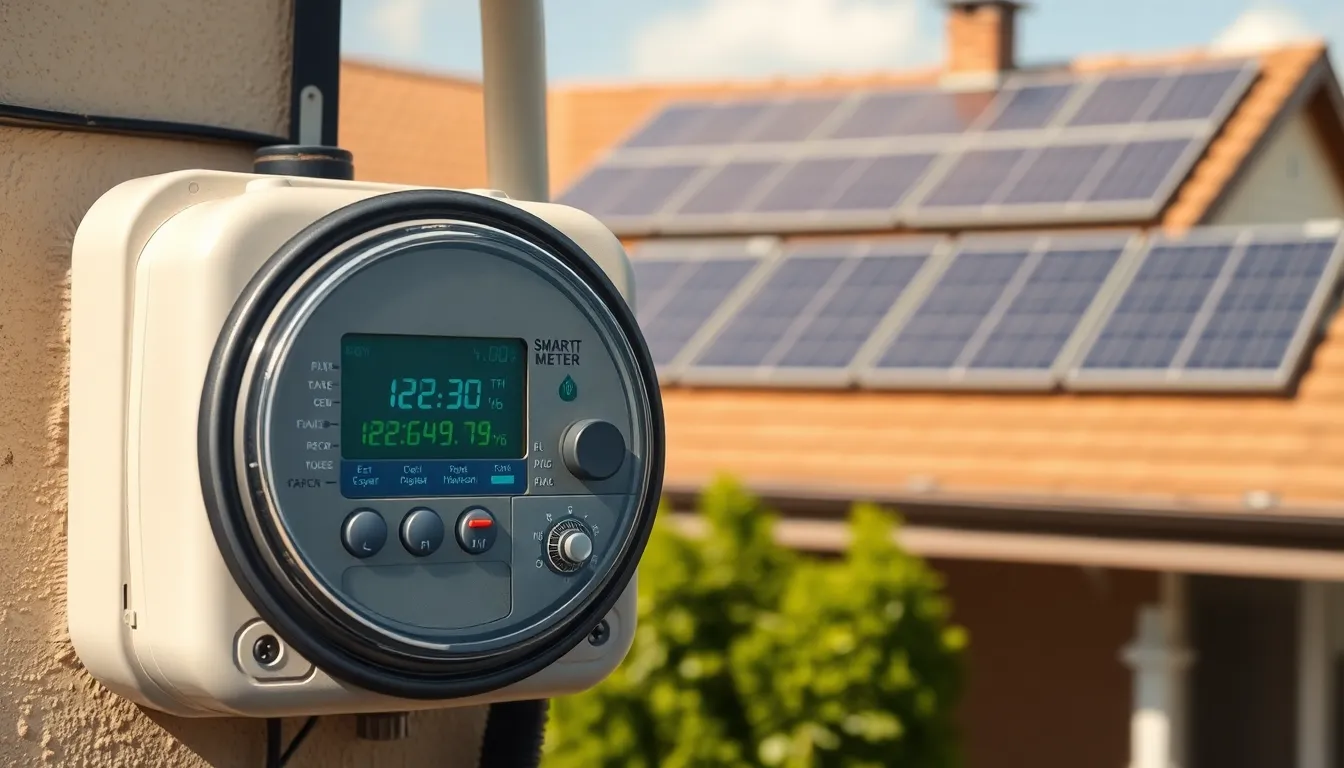Table of Contents
ToggleImagine a world where your toaster can chat with the power grid, ensuring your breakfast is perfectly timed while saving energy. Welcome to the realm of smart grid innovations, where technology meets electricity in a dance that’s both efficient and electrifying. These advancements are not just about turning your home into a high-tech haven; they’re about transforming the entire energy landscape.
Overview of Smart Grid Innovations
Smart grid innovations encompass advanced technologies that enhance the reliability, efficiency, and sustainability of electricity systems. These innovations include smart meters, which enable real-time data collection and communication between utilities and consumers. Smart meters empower users to monitor energy consumption and make informed decisions about their usage.
Automated demand response systems optimize energy distribution by managing consumption based on real-time availability. They help balance load demands during peak hours, preventing grid overload. Renewable energy sources, such as solar and wind, integrate seamlessly into smart grids, promoting clean energy usage.
Energy storage solutions play a crucial role in smart grids, storing excess energy generated from renewables for later use. Advanced battery technologies enhance energy storage capacities, allowing for smoother energy dispatch when demand peaks. Grid management software leverages big data analytics to predict energy trends, ensuring efficient resource allocation.
Electric vehicles (EVs) contribute to smart grid functionalities by providing vehicle-to-grid (V2G) capabilities. EVs can act as mobile energy assets, feeding electricity back into the grid during high demand periods. Communication protocols, such as those standardized by IEEE and IEC, facilitate interactions among devices within smart grids.
Cybersecurity measures focus on protecting the grid from potential threats, ensuring data integrity and system reliability. Increased investment in research and development accelerates innovation in smart grid technologies, enabling continual improvement.
Each of these innovations plays a vital role in reshaping the energy landscape. Adoption of smart grid technologies will likely lead to reduced energy costs and a more resilient energy infrastructure.
Key Technologies Driving Smart Grid Innovations

Smart grid technologies significantly enhance electricity systems’ reliability and efficiency. These innovations create dynamic interactions among devices, utilities, and consumers.
Advanced Metering Infrastructure
Advanced metering infrastructure (AMI) plays a crucial role in smart grid development. Smart meters enable real-time data collection, empowering consumers to track energy usage more accurately. Enhanced communication between utilities and users occurs, thanks to two-way communication capabilities. Data analytics allows for trend identification and usage patterns, resulting in informed decisions about energy consumption. Integration of AMI with home energy management systems boosts efficiency further. Utilities can manage demand response events more effectively due to this infrastructure, leading to optimized energy distribution during peak hours.
Energy Management Systems
Energy management systems (EMS) are essential in optimizing energy consumption and efficiency. These systems facilitate real-time energy monitoring, providing insights into usage trends. Advanced algorithms analyze data to suggest ways to reduce costs and improve energy efficiency. Users can easily integrate various energy sources, including renewables, into their systems. EMS fosters better load forecasting, ensuring grid stability. Automated controls enable adaptive responses to changing energy demands and conditions. Coordinated efforts between EMS and electric vehicles create a more dynamic energy landscape, where transportation becomes a key component of energy management.
Benefits of Smart Grid Innovations
Smart grid innovations offer significant advantages that enhance energy systems and consumer experiences. These innovations improve efficiency, reliability, and overall sustainability across the energy landscape.
Enhanced Energy Efficiency
Smart grids optimize energy consumption through real-time monitoring and data analysis. They allow consumers to track usage patterns, leading to better decision-making regarding energy use. Automated demand response systems adjust power use during peak times, minimizing waste and reducing costs. Integration with renewable energy sources further enhances efficiency by allowing for energy generation when conditions are favorable. Advanced technologies enable appliances to communicate with the grid, adjusting power draw based on availability, which maximizes resource utilization. Overall, these features contribute to lower energy bills and a reduced carbon footprint.
Improved Reliability and Resilience
Reliability stands as a hallmark of smart grid innovations. Enhanced communication systems provide utilities with immediate feedback on system performance, allowing for quicker identification of outages and issues. With resilience to disruptions, the grid efficiently manages incidents, minimizing downtime. Energy storage solutions play a crucial role in ensuring a stable supply, storing excess energy generated by renewable sources for later use. Furthermore, electric vehicles serve as mobile assets, providing additional backup when demand surges. As a result, smart grids contribute to an energy landscape that adapts and recovers effectively from challenges.
Challenges and Considerations
Smart grid innovations present significant challenges. Addressing these concerns is crucial for successful implementation.
Cybersecurity Risks
Cybersecurity risks pose substantial threats to smart grids. Hacker attacks can disrupt power supply, leading to widespread outages. Data breaches expose sensitive consumer information and can compromise the integrity of the grid. Ensuring advanced security protocols protects infrastructure from cyber threats. Systematic monitoring and rapid response measures enhance security. Collaboration among stakeholders fosters a collective defense strategy against potential vulnerabilities. Investment in robust encryption techniques fortifies data exchanges. Continuous training for personnel prepares teams to handle cybersecurity incidents effectively.
Regulatory Barriers
Regulatory barriers hinder the swift adoption of smart grid technologies. Complex compliance requirements can slow down innovation and deployment. Outdated regulations may not accommodate new technologies, creating gaps in legal frameworks. Streamlining regulatory processes supports quicker integration of smart solutions. Creating incentives for utilities encourages investment in advanced infrastructure. Stakeholder collaboration helps shape policies that align with technological advancements. Public-private partnerships leverage resources to overcome regulatory limitations. Continuous dialogue among regulators, utilities, and technology providers fosters an adaptive regulatory environment.
Future Trends in Smart Grid Innovations
Emerging technologies are shaping the future of smart grid innovations. Artificial intelligence (AI) and machine learning (ML) increasingly play a role in optimizing energy management. Enhanced data analytics techniques provide utilities with deeper insights into consumption patterns, enabling proactive measures.
Increased adoption of distributed energy resources (DER) transforms how energy is generated and consumed. Decentralized systems allow for localized energy production, reducing transmission losses and enhancing efficiency. As battery technologies advance, energy storage capabilities expand, facilitating greater integration of renewable sources.
Smart meters evolve to offer more than basic data reporting. Advanced functionalities allow consumers to engage with their energy use actively, promoting energy-saving behaviors. Energy management platforms make it easier for households to monitor and control appliances, further optimizing usage.
Electric vehicles become integral components of smart grids through vehicle-to-grid (V2G) initiatives. Not only do EVs store energy, but they also serve as mobile power sources, enhancing grid stability during peak demand.
Cybersecurity measures adapt to counteract evolving threats to infrastructure. Sophisticated protocols ensure data privacy while reinforcing overall system security. Regulatory frameworks also adapt to encourage innovation, allowing for faster deployment of smart grid technologies.
Collaboration among industry stakeholders fosters an ecosystem where innovation can thrive. Investment in research and development drives future advancements, leading to more resilient energy systems. Continued integration of IoT devices enhances communication across platforms, improving the user experience.
Overall, these trends indicate a significant shift towards more intelligent and flexible energy management, ultimately transforming the energy landscape and supporting sustainability goals.
Smart grid innovations are reshaping the energy landscape by enhancing efficiency and sustainability. As technology continues to evolve the integration of smart meters automated demand response and energy storage solutions is driving a more responsive energy system. These advancements not only lower energy costs but also promote a greener future by reducing carbon footprints.
Addressing challenges such as cybersecurity risks and regulatory hurdles is essential for the successful implementation of these technologies. The future of smart grids looks promising with the increasing adoption of AI and machine learning enabling smarter energy management. Continued collaboration and investment in research and development will pave the way for a resilient energy infrastructure that meets the demands of tomorrow.



